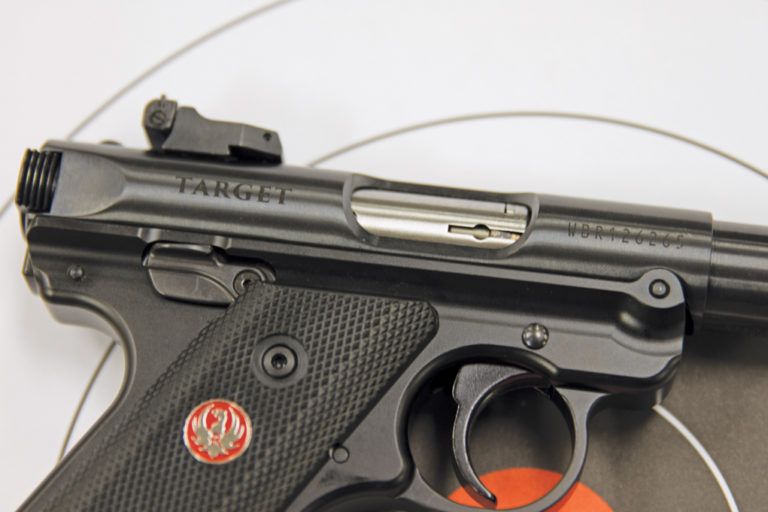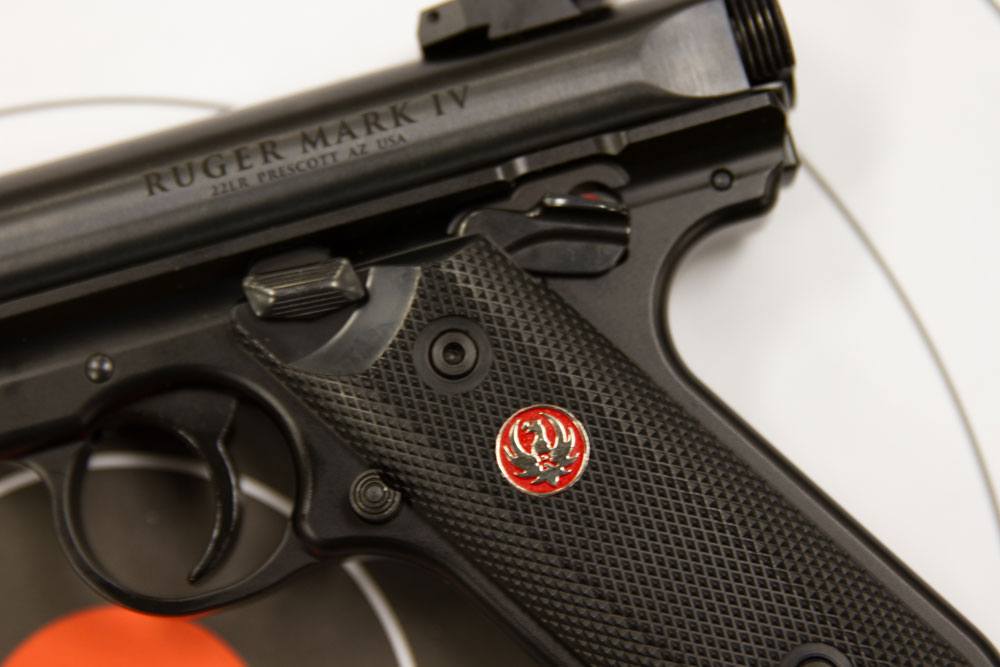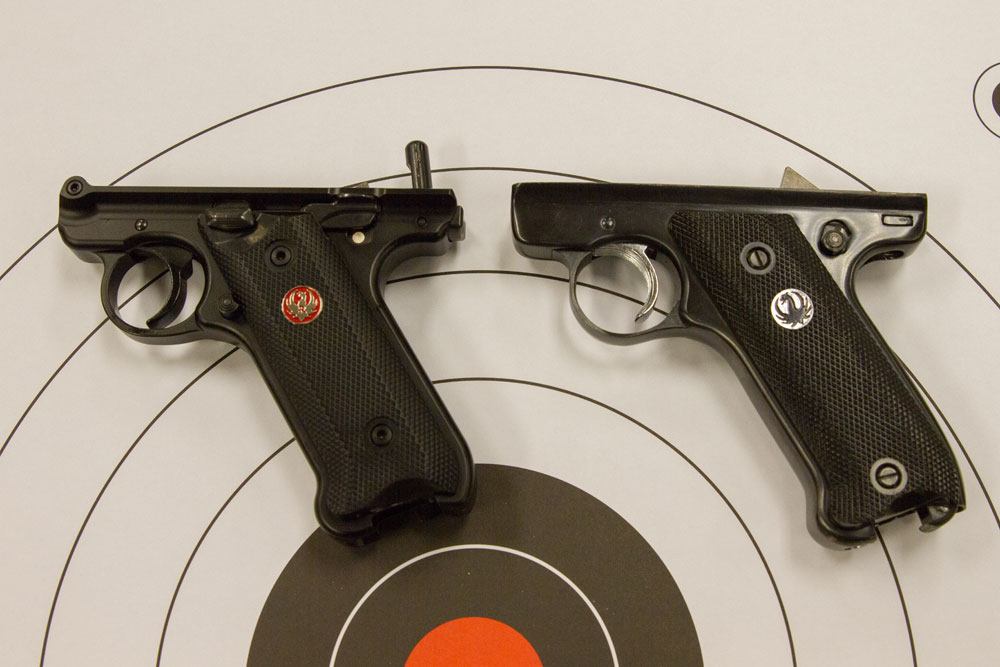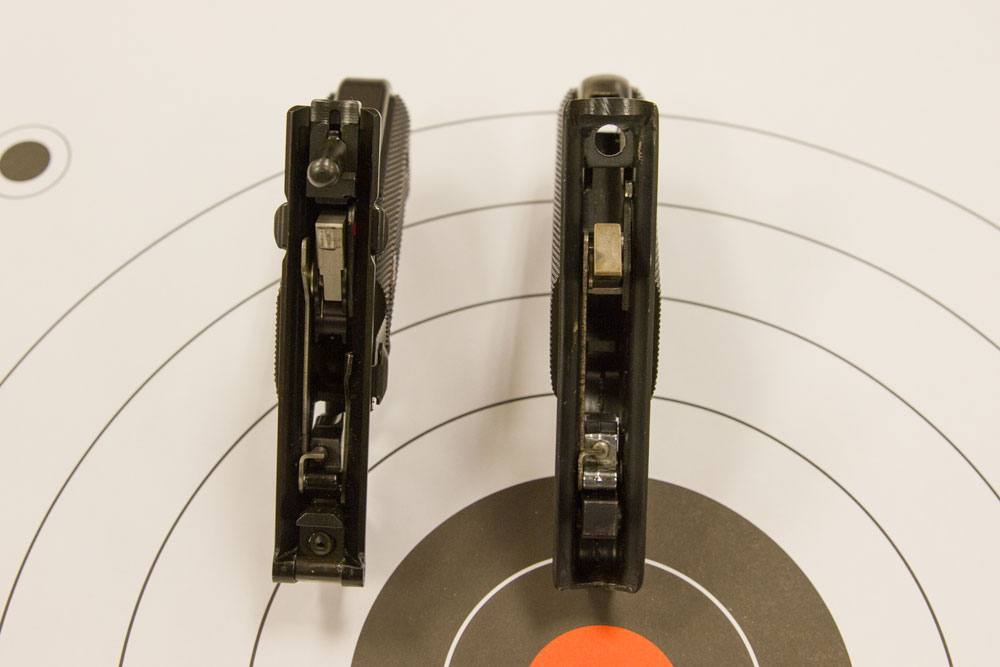
The new Ruger Mark IV Target .22 LR pistol is the latest version of the original and well-known Ruger semi-automatic .22 handgun.
- First introduced by Ruger as the Standard Model, the new Mark IV features many refinements.
- Takedown disassembly and reassembly is much simpler with the new Mark IV.
- There are several variants of the Mark IV, including the Target, Competition and Hunter.

Evolution of the Ruger Mark IV Target
Older shooters remember when Sturm, Ruger & Company appeared, and how its reputation grew as a maker of some of the most robust, yet reasonably priced, firearms available. The first offering was a .22 Long Rifle semi-automatic handgun, which has evolved from the Standard model to the newly introduced Ruger Mark IV Target.
After WWII, Bill Ruger decided he wanted to build a .22 Long Rifle semi-automatic pistol of his own design, and about that time he met Alexander Sturm, a young man who had access to the capital needed.
Ruger told Sturm about his pistol idea, and in 1949, with Sturm’s money, created Sturm, Ruger & Company. In a small building they called the “red barn” in Southport, Connecticut, they produced 2,500 Standard model pistols during their first year in business.
The Standard had a Japanese Nambu pistol-inspired bolt that was housed inside a tubular receiver, which was permanently attached to the rear of a 4.75-inch barrel.
Find Out More About Ruger Firearms
The finished gun looked a little bit like the P08 Luger, which at that time was highly sought after, especially as a war souvenir. That resemblance probably helped spur the popularity of the new gun, especially considering that the list price in 1949 was about $38 – less than the list price of its major competitors.

Then in 1950, Ruger released a newer model called the Mark I Target featuring a 6-inch barrel and adjustable sights, while production of the Standard with its fixed sights continued. Manufacture of the Standard and Mark I ended in 1981 when they were replaced by the Mark II Standard and Mark II Target.
Both featured a bolt hold-open lock, loaded chamber indicator and magazine disconnect.
The Mark III was introduced in 2004 and had a magazine release button on the left side of the frame instead of the heel clip used on previous models.
Then a stainless steel hunter model appeared that had a fluted bull barrel, fiber optic front sight and adjustable rear sight. A stainless steel Competition model was then introduced with an adjustable rear sight and slab sided bull barrel.
A Closer Look At The Ruger Mark IV Target
Most recently we have the introduction of the Mark IV models. Prior to the Mark IV, a latch located on the mainspring housing had to be pulled down in order to disassemble the gun. It was an awkward operation.
Then, when assembling the gun, care had to be taken to get the hammer strut properly aligned with the mainspring plunger in the mainspring housing. This takedown and assembly design caused criticism and more than a few trips to the gunsmith to find out why the gun did not work properly once the owner had tried to assemble it.
In its September 22, 2016, press release introducing the Mark IV, Ruger leads off by announcing a new, much simpler method of disassembling the gun. Instead of the latch, a takedown button located at the rear of the grip frame just below the receiver is pressed and the barrel/receiver assembly tilted down at the muzzle until the bolt stop pin is cleared.
The barrel/receiver assembly can then be lifted away from the grip frame. At that point, the bolt can be removed from the receiver. Assembly is in reverse order.
For comparison purposes, a vintage Ruger Standard model originally purchased new in 1971 for a retail price the owner recalls as being less than $50 was located. Thousands of rounds have been fired through the gun, but it still functions well, just as it did when first purchased.
A close examination shows evidence of marring on the mainspring housing where on more than one occasion the owner had difficulty lowering the takedown latch during disassembly. The bore is still bright and the rifling sharp, while the original blue is slightly worn in a few places.

The original owners manual still accompanies the gun and reflects the times during which the gun was made. Six pages long, with only three pages of instructions, a title page and two pages devoted to a parts diagram and parts list; there are no long warning paragraphs. Instructions are short.
Even new gun owners at the time were rightfully expected to have some basic knowledge of firearms and how to handle them, so that long, detailed descriptions and warnings were not characteristic of most owner manuals. And because most people had common sense and took responsibility for their own actions, a person being injured with a firearm did not necessarily spur a lawsuit against the manufacturer.
Looking inside the frame on the older gun reveals that it was built by forming two sheets of steel and then welding them together. In comparison, the new Mark IV frame is CNC machined from solid metal to improve strength and precision.
Other features of the Mark IV not found on the older Standard model include an ambidextrous safety located above and to the rear of the grip panels. There is also a bolt catch located on the left side of the frame above the grip panel, which is activated after the last round is fired, holding the bolt to the rear.
On the old Standard model, the bolt does not lock back after the last round is fired, and the safety doubles as the bolt catch only when the bolt is manually held to the rear and the safety selector pushed up.
The Mark IV has a magazine release located on the left side just to the rear of the junction of the trigger guard and front strap. This is in contrast to the magazine release on the original Standard model, which is a heel clip.
Additionally, the Mark IV is equipped with a magazine disconnector that prevents firing unless the magazine is in place. The older Standard model does not have this controversial feature.
The Mark IV rear sight is adjustable for windage and elevation by turning adjustment screws, while the rear sight on the old Standard model is fixed. The front sight on both guns is a fixed blade, although a Hunter model Mark IV is offered with a fiber optic. Mark IV receivers are drilled and tapped for the installation of an optic, except for the 22/45 Lite that has a factory-installed Picatinny rail in addition to iron sights.

Although it was not possible to obtain a sample Mark IV for accuracy testing because of deadlines, the accuracy potential of the gun is high due to the fact that the sights are firmly mounted to the barrel/receiver assembly rather than on a reciprocating slide. This means that the barrel and sights are permanently aligned during firing and disassembly/assembly, eliminating any movement that could reduce accuracy.
Ruger offers several models within the Mark IV series, including the blued Target with an aluminum grip frame, as well as a model with a bright finish stainless steel grip frame and barrel/receiver assembly.
Then there are the Hunter in stainless steel and the 22/45 Lite that features a grip frame with a grip angle similar to that of the 1911 pistol. Within the various models, the company offers a variety of features. More information about the Mark IV and features available can be found at www.ruger.com.
Editor’s Note: This article appeared in the Gun Digest 2018 annual available exclusively at GunDigestStore.com.
Get More Ruger Info:
- Great Ruger Guns
- Ruger No. 1
- Ruger Precision Rifle
- Ruger Redhawk
- Ruger Super Redhawk
- Ruger Blackhawk
- Ruger Single Six
- Ruger 10/22
- Ruger LCR
- Ruger LCRx
- Ruger 77/22
- Ruger 77/44
- Ruger SR1911
- Ruger Hawkeye
- Ruger SR-556
- Ruger LCP II
- Ruger American Magnum
- Ruger American Rifle
- Ruger Gunsite Scout Rifle
- Ruger SR-762
- Ruger Red Label
- Ruger SR40
- Ruger Single Nine
- Ruger P345

Next Step: Get your FREE Printable Target Pack
Enhance your shooting precision with our 62 MOA Targets, perfect for rifles and handguns. Crafted in collaboration with Storm Tactical for accuracy and versatility.
Subscribe to the Gun Digest email newsletter and get your downloadable target pack sent straight to your inbox. Stay updated with the latest firearms info in the industry.

![Best Concealed Carry Guns In 2025 [Field Tested] Wilson Combat EDC X9S 1](https://gundigest.com/wp-content/uploads/Wilson-Combat-EDC-X9S-1-324x160.jpg)


![Best 9mm Carbine: Affordable PCCs [Tested] Ruger Carbine Shooting](https://gundigest.com/wp-content/uploads/Ruger-Carbine-Shooting-100x70.jpg)
![Best AR-15: Top Options Available Today [Field Tested] Harrington and Richardson PSA XM177E2 feature](https://gundigest.com/wp-content/uploads/Harrington-and-Richardson-PSA-XM177E2-feature-100x70.jpg)

I sure hope they fixed the issue with the magazine release. I have a MKIII Target and if I try to run a timed fire exercise I wind up getting the magazine stuck against the release button, because the magazine slops around in the mag well and twists from side to side going in unless you slow down to make sure it goes in straight. When I called Rugers customer service and explained the problem they told me that it would wear in not to worry. So there target pistol is really a joke, if I want to shoot timed fire I use my Browning buckmark I don’t have any problems putting the magazine as fast as I can. No more Rugers for me for target shooting. Lousy customer service.